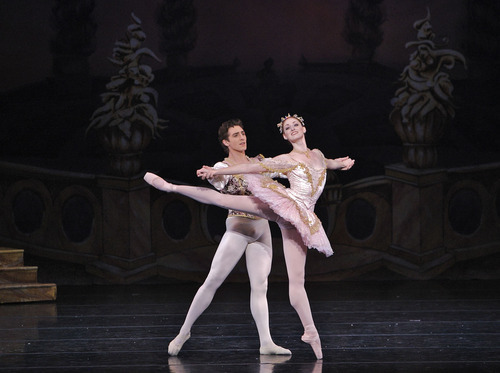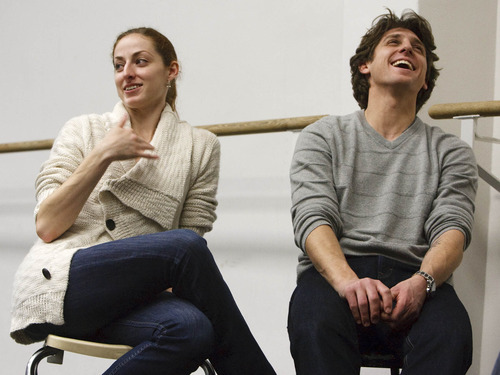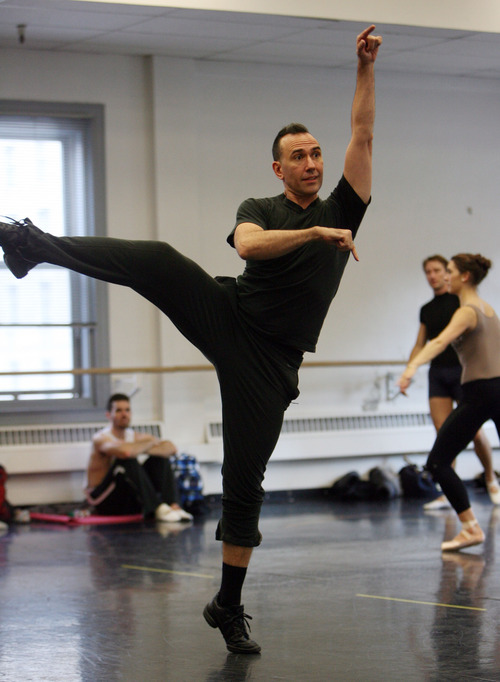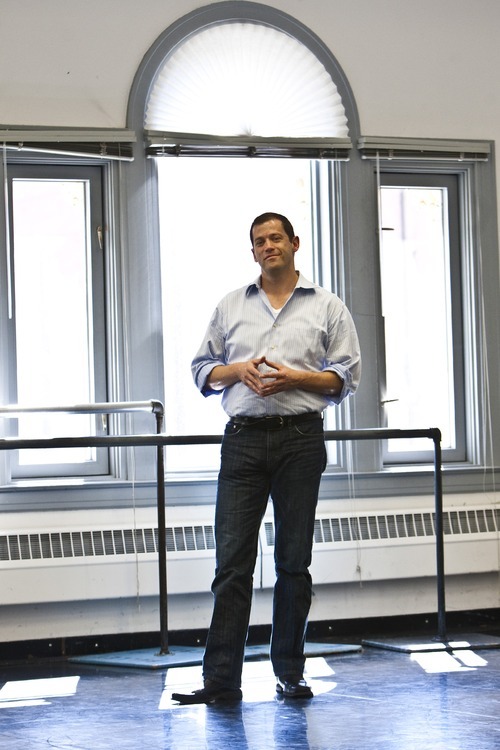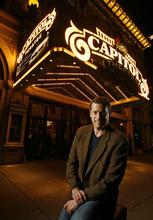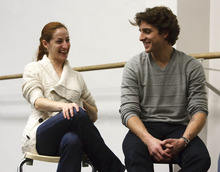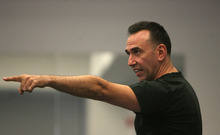This is an archived article that was published on sltrib.com in 2012, and information in the article may be outdated. It is provided only for personal research purposes and may not be reprinted.
When Adam Sklute arrived in Salt Lake City for his Ballet West interview in February 2007, it was during a record-breaking week for the worst air quality in the nation. His interview for the artistic directorship was on Monday, and as he stepped off his flight from Chicago into the inversion, he was greeted by a typical Sunday night in downtown Salt Lake City — quiet, closed and empty.
The next morning, Sklute recalls opening the curtains of his room at the Downtown Hilton and "gazing upon the most beautiful mountain range I had ever seen." Seeing the jagged Wasatch Front, against a brilliant blue sky, Sklute says he began falling in love with the city, the people and Ballet West.
It was a complicated time for the 44-year-old company, which was still rooted in the traditions and memory of its founder, the well-loved Willam F. Christensen. The search came on the heels of the controversial, hurried removal of Jonas Kåge, nine years into the artistic director's 10-year contract. So in addition to the usual vetting from board members and administration, Sklute would have to pass inspection from company dancers, as well as Christensen's successor, former artistic director Bruce Marks, and a select group of arts-community members.
Sklute, then co-associate director of the Joffrey Ballet, wasn't particularly nervous about the interview. "At the time, I was being considered for the artistic directorship of the Joffrey Ballet, where I intended to stay for the rest of my career," he says.
He says he's embarrassed to admit this now, but when he was invited to apply for the Ballet West job, he followed through mostly to find out his market value outside the company where he had spent most of his career.
In that first interview, the selection committee was impressed at Sklute's ideas, recalls chair Pete Meldrum, president and CEO of Myriad Genetics. As Sklute talked, Meldrum noticed the committee's "side of the table getting very excited about this candidate who was head and shoulders above the other very qualified candidates."
At the same time, Sklute also began to reconsider his "very callous" reasons for coming to Utah. He started changing his mind about stepping into the shoes of Robert Joffrey or Gerald Arpino, Joffrey's founder and then-retiring artistic director. In his first full day in Salt Lake City, Sklute started thinking about his future differently, about the prospect of leading "an organization where I could really make a difference."
—
Branding Ballet West nationally • Five years later, Sklute has accomplished much of what he was asked to do when he took over, raising the artistic quality of the company's dancing and increasing its national visibility, while revitalizing Ballet West Academy.
Along the way, he's helped develop and stage new works — an achievement that will be showcased this weekend with the world premiere of choreographer Val Caniparoli's "The Lottery." He's sparked the attention of younger audiences through the big marketing gamble of the docu-reality TV show "Breaking Pointe." The show, filmed backstage at Capitol Theatre, was just renewed by The CW network for a second season, complete with the promise of up to $362,500 in tax breaks approved by the board of the Governor's Office of Economic Development. Filming is scheduled to begin in January.
Sklute, who combines his creative sensibilities from his career as a dancer with his experience in arts management from Joffrey, isn't anywhere near done.
The list of his new initiatives is long. Last season, Salt Lake City patrons were treated to a new family series show,"The Little Mermaid," a performance specifically for children danced by Ballet West II, apprentices and academy dancers.
In addition, Sklute announced the hiring of Nicolo Fonte as resident choreographer, a role that underscores the company's ambitions to create a stylistic brand. To fill the podium of retiring longtime music director Terence Kern, Sklute decided to audition a different guest conductor for each Ballet West performance.
Ballet West programming under Sklute reminds arts advocate Anne Cullimore Decker of the strategy of longtime Utah Symphony music director Maurice Abravanel.
"Maurice had innovative ideas, with specific ways to implement them," Decker said. "In a program, he'd do a little Beethoven, a little Brahms, and then slip in a Bartók. I think Adam is like that; he knows how to balance something different with something familiar."
—
Enterprising, yet anchored • The company's ambitious programming has garnered national attention. Since 2008, New York Times head dance critic Alastair Macaulay has reviewed Ballet West four times. In a phone interview, Macaulay said he hadn't seen the company under other directors, but "the two programs for which I came to Salt Lake City made me feel that the journey was very well worth it."
"The Diaghilev program that Sklute put on in 2009 was really enterprising," Macaulay said. "The ballets were chosen to celebrate the centenary of when Diaghilev's Ballets Russes started in Paris. I think no other American company that year presented a real triple bill."
As Macaulay wrote in an April 4, 2009, review: "Ballet West's current 'Treasures of the Ballets Russes' triple bill proves the most stimulating Diaghilev anthology I have seen in more than 30 years."
Under Sklute's direction, Ballet West has expanded its repertoire while staying close to its roots. For example, the opener for the 2009-10 season included Marks' "Songs of the Valley," a ballet he choreographed one year after Christensen asked him to join him as co-artistic director in 1975. (Marks led the Utah company from Christensen's 1978 retirement until 1985, when he was offered the directorship of Boston Ballet, one of the nation's largest and most respected companies.)
"Choreographers can make work anywhere," Marks said, "but the director of a regional repertory company has different incentives. You're thinking about your city, your dancers and the development of the company. I think Adam is very aware of that."
Marks said he is honored to revive the ballets he choreographed at Ballet West. "The recognition of former directors is unique. For the past 250 years, it has been the tradition in ballet to come in and obliterate every memory of former directors' work. So thank goodness Adam is secure enough not to do that."
—
From distress to thriving • Sklute's passion has kindled interest from business and arts community members, such as Victor S. Rickman, senior vice president of UBS Financial, now in his third year on Ballet West's board.
Rickman has a long history supporting ballet at the professional company and at the University of Utah. "This was a company in distress and now it is a thriving place," Rickman said. "Sklute is tireless in his promotion of the company. He wants to build both Ballet West II and the Academy into a destination for young dancers from all over the world. BW II is now a springboard into the main company, and the Academy is full."
"One busy guy" is how Rickman describes Sklute, as he inventories his hands-on approach. "I go up there to the studio, and there is he is teaching company class, and then he's off to judge a competition giving him an inside track on bringing the best young talent. And, of course, the recent connection with 'Breaking Pointe' and increased touring."
From the first, dancers liked Sklute's ideas of where he would take the company, says Kate Crews, who retired in 2010 after 10 seasons at Ballet West. Crews now directs a new dance program at Sandy's Waterford School. "At first, the changes were not huge, but he wanted to make sure the rep was stimulating for the dancers," Crews said.
Company principal dancer Christiana Bennett recalls Sklute's first days with the company. Bennett was hired at Ballet West in 1999 and promoted to soloist in 2004. Unlike some of the company's older dancers, who decided the transition was a good time to retire, she stayed on.
"It took us a little time to develop the artistic relationship and trust each other," she said, comparing the process of getting to know a new director to that of dating. "I felt the need to be on top of my game, so it was a bit of an adrenalin rush."
Sklute has challenged the company through programming choices. "Adam brings a diversity of work, which provides exposure to more techniques and styles," Bennett said.
Bennett especially appreciates Sklute's hiring skills and becomes emotional when she speaks of ballet master Mark Goldwebber, who died of cancer in September 2011. "He was the best thing that ever happened to me. He was a consummate professional, a constant affirmation of wanting the very best for me every time I went out onstage."
Goldwebber is just one example of the talented staff Sklute has gathered at Ballet West, many of whom he knew from his days at Joffrey, such as production manager Michael Currey and academy instructor and U. ballet teacher Calvin Kitten.
Another change has come in the company's structure, as the classical designation of principals, soloists, demi-soloists, artists and Ballet West II members has morphed from a small top- and bottom-heavy structure to an expanding middle section. Such changes determine the repertoire of the company, and while a looser stratification might open up casting, it could also bring more ferocious competition.
—
Creative ambitions • In his first year in Utah, Sklute launched "Innovations," a showcase of new choreography from within and outside the company. Ballet West dancers are invited to apply to create new dances; those selected see their work produced alongside commissioned work by established choreographers.
Those efforts will expand through Sklute's announcement of Fonte as resident choreographer — a position the company hasn't filled since Caniparoli's stint from 1994-97. Fonte will be commissioned to create at least one new ballet each season. The risk comes in branding the company with a particular choreographer's style, which might be comparable to celebrity casting in theater or hiring a marquee player for a sports team. The question is: Can new works sell tickets?
"New choreography or ballets that have recently been made elsewhere are the lifeblood of all companies," said Macaulay, the dance writer. "It's what develops dancers as artists. But it's really up to people to come watch the repertoire to decide if those choreographers and their ballets are the best choices."
An even bigger roll of the dice came last year when Sklute agreed to allow television cameras into the studio and personal lives of his dancers for "Breaking Pointe." The move generated sidewise glances from the ballet world, while eliciting awe for the background shots of Utah's mountains and Salt Lake City's Capitol Theatre.
"The summer of 2012 may well go down as the summer that 'Breaking Pointe' introduced reality television — and its fans — to the cloistered world of classical ballet," wrote Karyn D. Collins in an online story for Dance/USA.org, her article provocatively titled with this question: "Can 'Breaking Pointe' Fix Ballet?"
Last summer, when the Dance Critics Association conference convened in New York City, the event's most lively discussion erupted over the TV show at a panel discussion centered on Sklute's explanation of why he was willing to place high art in a low-art format. The show "was no different in my mind than producing a brand new ballet, and that's always a risk," Sklute said, adding that if television increases live-performance attendance, "why not use this format?"
The show averaged fewer than a million viewers during its six-episode run from May 31 to July 5, a weak showing even for The CW. But "Breaking Pointe" attracted a large online audience, which prompted the network to greenlight a second season.
—
Reinvigorated by the art • Balancing the many facets of running the artistic side of the company is, of course, an exhausting pursuit. Sklute's partner, Christopher Renstrom, trained as a playwright at The Juilliard School and as an actor at New York University. Renstrom's publishing career has included writing plays and reporting for fashion magazines, although he is best known for his astrology columns.
Sklute, who relies on Renstrom to edit his writing, says he's grateful that his partner's career allowed him the freedom to move away from publishing world connections of Chicago and New York City.
"I'm very fortunate that I am able to call my profession my art form," Sklute said. "This is a great gift that I've been given and I never forget that. Both Christopher and I live our lives committed to and being grateful for our respective art forms."
About Adam Sklute
Hometown • Berkeley, Calif.
Age • 47
Education • Oakland, San Francisco and Joffrey ballet schools
Partner • Writer/journalist Christopher Renstrom
Résumé highlights • Danced with the Joffrey Ballet for more than a decade after becoming one of the last two dancers promoted to the company by Robert Joffrey; performed with New York's Metropolitan Opera Ballet, Dallas Metropolitan Ballet and California's Diablo Ballet; lectures on ballet and teaches dance workshops nationwide; helped develop the Joffrey's apprentice program to train young dancers for the company; appeared in Robert Altman's 2003 ballet movie, "The Company"; credited as creative consultant/featured performer in BBC Worldwide's "Breaking Pointe"
Ballet West • Appointed the company's fifth artistic director in 2007, following company founder Willam F. Christensen, Bruce Marks, John Hart and Jonas Kåge.
Company • Founded in 1963; currently, 40 dancers, 11 second company members, and a training academy



